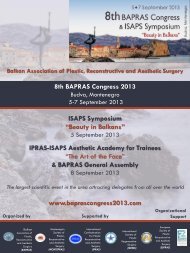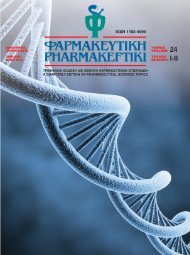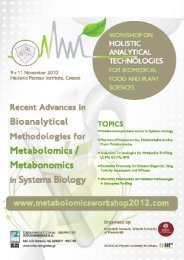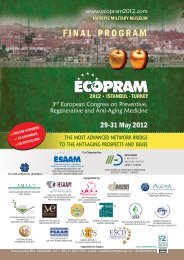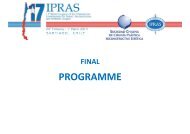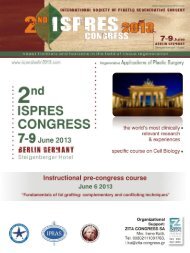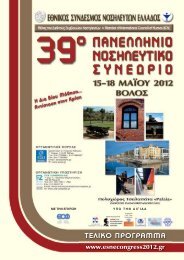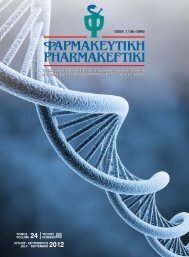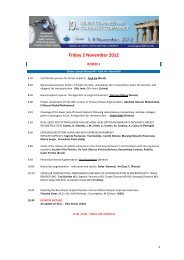S U R V E Y SHonoured with the award of “Ivo Pitanguy”during the 48th Brazilian congress of plastic surgeryLiposuction induces a compensatory increase of visceralfat which is effectively counteracted by physical activityAuthor: Eduardo Montag aSub-authors: Fabiana Braga Benatti b ; Fábio Lopes Saito a ; RolfGemperli a ; Antonio Herbert Lancha Junior ba) Division of Plastic Surgery and Breast Surgery Group,University of São Paulo School of Medicineb) School of Physical Education and Sport –University of Sao PauloLiposuction is one of the most popular aesthetic surgeriesperformed worldwide, but its long-term impact on bodycomposition and on the metabolic profile remains unclear.It has been speculated that the immediate decrease in bodyfat may trigger feedback mechanisms of body-fat regain.In several species, surgical fat removal is accompanied byfat regain within a few weeks, mostly due to compensatoryfat growth in the intact depots. Recent data has confirmedthat women undergoing liposuction gain upper-bodyfat within six months, which may be associated withincreased cardiovascular risk. Importantly, no studyof the long-term effects of liposuction has controlledfor the subjects’ physical activity levels which may beconsidered an important confounder because exerciseper se is believed to improve body composition. Thus,the purpose of this study was to investigate the effectsof small-volume abdominal liposuction on body fatdistribution in normal-weight women, who were eitherexercise-trained or not after surgery. We hypothesizedthat liposuction surgery would cause body-fat regain inphysically inactive subjects, whereas a supervised exercisetraining program would counteract such detrimentaloutcomes. A six-month randomized controlled trial wasconducted. Thirty-six women underwent a small-volumeabdominal liposuction (20 to 35 years old; BMI: 23,8 ±2.2 Kg/m2). Two months after surgery, the subjects wererandomly allocated into one of the two groups (trained,T, n=18; or non-trained, NT, n=18). Trained subjectsundertook a four-month exercise program. Non-trainedsubjects remained physically inactive throughout thestudy period. Prior to the intervention (PRE), immediatelybefore the beginning of the exercise program (i.e., twomonths after surgery, or POST2) and at the end of thestudy (POST6), food intake and body composition wereassessed. Energy expenditure, dynamic strength andaerobic fitness were assessed at PRE and POST6. POST6 assessments were performed 60 to 72 hours after thelast training session in the trained group. Subjects wereinstructed to maintain their food intake pattern throughoutthe study. Liposuction was effective in reducing bodyweight, fat mass, and subcutaneous abdominal fat (SAT)(PRE vs. POST2, p=0.0001). Despite the sustained SATdecrease at POST6 (p=0.0001), body weight returned tobaseline values in both groups. The NT group showeda significant 10% increase in visceral fat (p=0.04) anddecreased energy expenditure (p=0.01) when comparedwith TR. TR showed an increased fat-free mass (p=0.03)and improved physical capacity (p
Honoured with the award of “Evaldo D’Assumpção”during the 48th Brazilian congress of plastic surgeryDevelopment of experimental model of avulsionof the flaps in the lower limbs of ratsAuthors:Dimas André Milcheski, MD aHugo Alberto Nakamoto, MD aPaulo Tuma Jr, MD aLucas Nóbrega, Medical Student bMarcus Castro Ferreira, Professor and Chairman aa) Division of Plastic Surgery, Faculty of Medicine,University of São Paulo, São Paulo, Brazilb) Faculty of Medicine,University of São Paulo, São Paulo, BrazilIntroductionDegloving injuries of the lower limbs are frequentlycharacterized as severe injuries and there is difficulty indeciding what the best surgical approach is1.PurposeThe aim of this study was to develop a deglovingexperimental model in rat hind limbs and to observe theviability of the flap after its repositioning to the bed wound,in order to study the changes related to this injury.MethodNinety male Wistar rats were divided into fourexperimental groups (G1 = 22, G2 = 24, G3 = 22, G4 =22). A degloving model was performed in the rats’ hindlimb based on four different pedicles as follows: G1 -proximal flow, G2 – distal flow, G3 – lateral flow, and G4– medial flow (Figures 1 and 2).After the incision mark, the skin and subcutaneous tissuewere incised. Four Backhaus clamps were positionedat the edge of the skin incision margin and progressivecontrary traction was applied, strong enough to producea degloved flap of the subcutaneous tissue and skin of thehind limb, resulting in a partial avulsion flap. After fiveminutes the flap was repositioned in its original situationand the incision was closed with continuous skin suture(nylon 5.0).The rats were observed daily for signs of flap necrosisfor 7 days (Figure 3), after which they were sacrificed byoverdose of thiopental.Measurements of the areas of necrosis in the flap, as wellas the total area of the flap, were performed after totalremoval of the avulsed flap. The flap wasthen laid on the operating table and photographed (Figure4). Photographs were taken of each rat and analyzed usingImageJ software2, which is suited for area calculation.Total flap area (cm2), area of necrosis in the flap (cm2) andthe ratio between the necrotic and total areas (percentage)were determined.Statistical analysis was performed using Kruskal-Wallisnonparametric test for independent samples among thefour groups. The Dunn test of multiple comparisons wasused to assess differences between matched group pairs.Significance level was 95% (p < 0.05). The statisticalanalysis was done with the software Prism 4b forMacintosh, version 4.0 (Graphpad Software, Inc, USA).ResultsAfter exclusion of animals by flap autophagy and death,17 rats remained in the G1 and G2 groups, 15 rats in theG3 group and 16 rats in the G4 group. The total flap areawas 12.41 cm2 for the G1 group, 5.63 cm2 for the G2group, 3.88 cm2 for the G3 group and 4.25 cm2 for theRatio between the necrotic areaand total area of the avulsed flap.Issue 7 www.ipras.org <strong>IPRAS</strong> Journal 39
- Page 1: ISSN: 2241-1275
- Page 4 and 5: A I M S A N D S C O P E• To promo
- Page 7 and 8: within the range of statistically e
- Page 9 and 10: G E N E R A L S E C R E T A R Y ’
- Page 11 and 12: Issue 7 www.ipras.org IPRAS Journal
- Page 13 and 14: After Madrid came Beijing, China, f
- Page 15 and 16: From the left: Mr Alexey Kovalsky,
- Page 17 and 18: Mr. Zacharias Kaplanidis (IPRAS Exe
- Page 19 and 20: P I O N E E R SAn interview with Dr
- Page 21 and 22: of excellence is that of evidence-b
- Page 23 and 24: R I S I N G S T A RAn interview wit
- Page 25 and 26: Issue 7 www.ipras.org IPRAS Journal
- Page 27 and 28: Women from the mountains in Afghani
- Page 30 and 31: They must be confident. Security is
- Page 32 and 33: IPRAS (Asia-Pacific Section) organi
- Page 34 and 35: EntertainmentThe organizers were pa
- Page 36 and 37: Plastic Surgery Mission in Togo,Cla
- Page 40 and 41: 1). The Dunn test showed significan
- Page 42 and 43: Duoderm ® CGF ® and Hand modelare
- Page 44 and 45: where the trilobed flap 6 is used.
- Page 46 and 47: 46 IPRAS Journal www.ipras.org Issu
- Page 48: Plastic Surgery Hyperguide:An Inter
- Page 53 and 54: coming back to the scene has everyt
- Page 58 and 59: 23rd Annual EURAPS Meeting,Munich,
- Page 60 and 61: Surgeons conducted meetings in the
- Page 62 and 63: Panamanian Association of Plastic,
- Page 64 and 65: It was, however, not until shortly
- Page 66 and 67: in 1941, gaining a Masters Degree i
- Page 68 and 69: lack of funding and facilities for
- Page 70 and 71: Despite these hurdles, reconstructi
- Page 72 and 73: Patna, Lucknow, Bombay, Pune, Delhi
- Page 74 and 75: TPCDHistory and present situationof
- Page 76 and 77: andom choice of cases, watched by t
- Page 78 and 79: stimulated his interested in maxill
- Page 80 and 81: BAPRAS and the Developing WorldBrit
- Page 82 and 83: 82 IPRAS Journal www.ipras.org Issu
- Page 84 and 85: World Health OrganizationDear colle
- Page 86 and 87: 86 IPRAS Journal www.ipras.org Issu
- Page 88 and 89:
88 IPRAS Journal www.ipras.org Issu
- Page 102 and 103:
102 IPRAS Journal www.ipras.org Iss
- Page 104:
104 IPRAS Journal www.ipras.org Iss
- Page 109 and 110:
For the FIRST time…The 1st IPRASI
- Page 114 and 115:
NATIONAL & CO-OPTED SOCIETIES’ FU
- Page 116 and 117:
I P R A S W E B S I T EJOIN YOUR CO
- Page 118 and 119:
I P R A S P A S T G E N E R A L S E
- Page 120:
7th Issue December 2011IPRAS Journa



